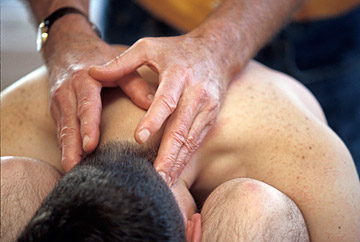Relief With Rolfing
In today's stressful world, the goal is to find peace of mind. But, what if a simple treatment helped to restore your flexibility, revitalize your energy and leave you feeling renewed overall?
Such a treatment does exist – it's called rolfing. Rolfing – a deep-tissue body work can help not only relieve your stress, but also ease pain and improve performance. The theory is that the body's aches and pains arose from basic imbalances in posture and alignment. Rolfing developed as a way to "restructure" muscles and fascia. Research has shown that this method not only helps muscles, but also allows your body to conserve energy and create better patterns of movement.
Rolfing is named after 1920's biochemist Ida Rolf, who studied alternative methods of bodywork and healing. Dr. Rolf's theory was that the body's aches and pains came from basic imbalances in a person's posture and alignment which were then created and reinforced over time by gravity and learned responses among the muscles and fascia. Fascia is the sheath-like connective tissue that surrounds and binds muscles together. Dr. Rolf developed this technique in order to restructure the muscles and fascia.
 According to the Rolf Institute of Structural Integration, founded by Dr. Rolf in 1971, "Driven to find solutions to her own health problems, Dr. Rolf spent many years studying and experimenting with different systems of healing and manipulation. Dr. Rolf posed this fundamental question: ‘What conditions must be fulfilled in order for the human body‐structure to be organized and integrated in gravity so that the whole person can function in the most optimal and economical way?' Her life's work was devoted to an investigation into the conditions that must be met for the person, as a whole, to function optimally. This investigation led to a system of soft tissue manipulation and movement education designed to organize the whole body in gravity. She discovered that she could achieve remarkable changes in posture and structure by manipulating the body's myofascial system. Dr. Rolf eventually named this system structural integration and later it was nicknamed "Rolfing" by clients and practitioners. In order to pass along her work to others, and to make the education process accessible, she developed an expedient series of ten sessions which came to be known as the Ten‐Series."
According to the Rolf Institute of Structural Integration, founded by Dr. Rolf in 1971, "Driven to find solutions to her own health problems, Dr. Rolf spent many years studying and experimenting with different systems of healing and manipulation. Dr. Rolf posed this fundamental question: ‘What conditions must be fulfilled in order for the human body‐structure to be organized and integrated in gravity so that the whole person can function in the most optimal and economical way?' Her life's work was devoted to an investigation into the conditions that must be met for the person, as a whole, to function optimally. This investigation led to a system of soft tissue manipulation and movement education designed to organize the whole body in gravity. She discovered that she could achieve remarkable changes in posture and structure by manipulating the body's myofascial system. Dr. Rolf eventually named this system structural integration and later it was nicknamed "Rolfing" by clients and practitioners. In order to pass along her work to others, and to make the education process accessible, she developed an expedient series of ten sessions which came to be known as the Ten‐Series."
According to the Institute, "Rolfing Structural Integration offers a combination of hands‐on bodywork and movement education. It manipulates the body's connective tissue, called fascia, to rebalance the body and may bring relief from chronic pain, stress, and injury. Using their fingers, hands, and elbows, Rolfers slowly work through deep layers of tissue to change structural patterns in the body by transforming fascial patterns and releasing restrictions. Results can be dramatic, and the process is not necessarily painful as it has been shown to be more effective if the body is more at ease during the work. Rolf Movement Integration offers education about one's body, so one can recognize habitual movement patterns and learn to move with greater ease, flexibility and freedom of expression whether simply walking or performing some special activity. Professional athletes, dancers, children, business professionals, and people from all walks of life have benefited from Rolfing Structural Integration."
Some people equate this technique with chiropractic or general therapeutice massage, but there is a difference and that difference comes in the focus. Chiropractic focuses more on the bones and therapeutic massage focuses on muscles, where rolfing focuses on manipulating the fascia. Because of this focus, it can seem to be a bit of an aggressive technique and can sometimes be painful. The pain comes from potential knots and scar tissue that can be found in the fascia. Trained rolfers will use knuckles, fists and elbows to really get into the tissue and loosen tendons and ligaments.
Talk to you massage therapist about rolfing to reduce chronic stress. While sometimes uncomfortable, patients will find a great reward if they can endure the hour long sessions.

